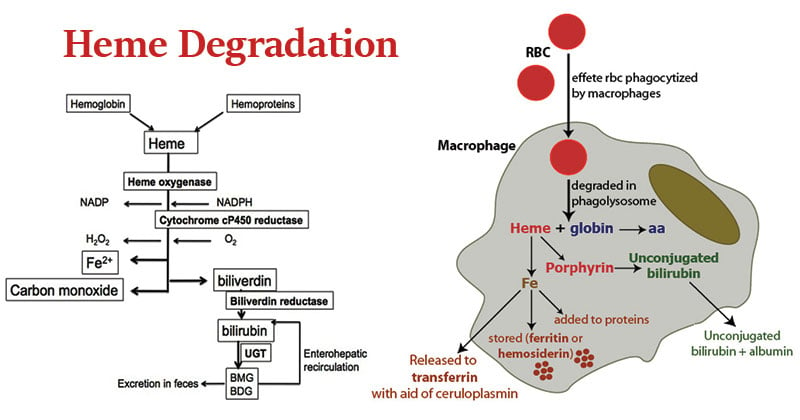Heme Degradation is the degradation of heme into biliverdin by heme oxygenase, and then biliverdin reductase converts biliverdin to bilirubin.
- Hemes are cyclic tetrapyrroles that contain iron and are commonly found as the prosthetic group of hemoglobin, myoglobin and the cytochromes.
- This small-molecule component of globins, critical for oxygen transport among other functions undergo a complex process of metabolism and degradation.
- Roughly 80% of heme destined for degradation and excretion comes from senescent erythrocytes which have circulated for on average 3 months.
- The other 20% comes from premature erythrocytes in the bone marrow which are destroyed prior to release into the circulation and a minor component is derived from other cell types.
Interesting Science Videos
Location of Heme Degradation
Various components of heme degradation occur in the cells of the reticuloendothelial system, liver, and intestine.
- Substrates: Heme; NADPH; 2 UDP-glucuronic acid.
- Product: Urobilinogen (excreted in urine); stercobilin (excreted in feces); carbon monoxide (CO); Fe 2+.
Heme Degradation Pathway

- Degradation begins inside macrophages of the spleen, which remove old and damaged (senescent) erythrocytes from circulation.
- RBCs are engulfed by cells of the reticuloendothelial system. The globin is recycled into amino acids, which are catabolized into intermediates of the citric acid cycle and fatty acid oxidation.
- Heme is oxidized; the heme ring is opened by heme oxygenase. The oxidation occurs on a specific carbon, producing the linear tetrapyrrole biliverdin, ferric iron (Fe 3+), and CO.
- In the next reaction, the second bridging methylene is reduced by biliverdin reductase, producing bilirubin. The green pigment is thus converted to the red-orange bilirubin.
- Bilirubin is then transported in the serum by albumin to the liver, where it is conjugated with glucuronate by bilirubin glucuronyl transferase and excreted in the bile.
- In the intestine, bilirubin is deconjugated and converted to urobilinogen and stercobilin.
- Some urobilinogen is reabsorbed and excreted as urobilin in the urine. Most urobilinogen is oxidized in the feces to stercobilin, which gives feces its color.
Reactions and Steps Involved in Heme Degradation
1. Conversion of Heme to Biliverdin
- Heme oxygenase breaks down heme, releasing biliverdin, CO, and iron.
- Heme degradation begins with the enzyme heme oxygenase, which breaks down heme into biliverdin, carbon monoxide (CO), and iron.
- This reaction involves the cleavage of the heme ring and the release of biliverdin as a product.
- Reaction: Heme + O2 → Biliverdin + Fe3+ + CO
- Enzyme: Heme oxygenase
2. Reduction of Biliverdin to Bilirubin
- Biliverdin reductase converts biliverdin into bilirubin, which is a yellow pigment.
- Biliverdin reductase is responsible for the reduction of biliverdin to bilirubin.
- This enzymatic reaction involves the transfer of electrons from NADPH to biliverdin, resulting in the formation of bilirubin.
- Reaction: Biliverdin + NADPH + H+ → Bilirubin + NADP+ + H2O
- Enzyme: Biliverdin reductase
Significance of Heme Degradation
- Free heme concentration greater than 1 micro M can be toxic because it catalyzes the production of reactive oxygen species. To cope with this problem, heme degradation is very crucial for the body.
- In animals, this pathway is an excretory system by which the heme from the hemoglobin of aging red blood cells, and other hemoproteins, is removed from the body.
- Products of degradation such as CO acts as a cellular messenger and functions in vasodilation. Other metabolites of heme also have additional important functions and are involved in various critical cellular events.
- Heme degradation is believed to be an evolutionarily-conserved response to oxidative stress.
- In higher plants, heme is broken down to the phycobiliprotein phytochrome which is involved in coordinating light responses.
- In algae, it is metabolized to the light-harvesting pigments phycocyanin and phycoerythrin.
Heme Degradation Associated Diseases
In patients with abnormally high red cell lysis or obstructive liver damage, bilirubin can accumulate, leading to the clinical manifestation of jaundice.
Conclusion
Heme degradation aids in the removal of surplus heme and its byproducts, guaranteeing efficient waste disposal and antioxidant defense. Understanding the intricate processes of heme production and degradation will help us better understand how biological systems work and how heme-related diseases develop.
References
- David Hames and Nigel Hooper (2005). Biochemistry. Third ed. Taylor & Francis Group: New York.
- Smith, C. M., Marks, A. D., Lieberman, M. A., Marks, D. B., & Marks, D. B. (2005). Marks’ basic medical biochemistry: A clinical approach. Philadelphia: Lippincott Williams & Wilkins.
- John W. Pelley, Edward F. Goljan (2011). Biochemistry. Third edition. Philadelphia: USA.
- http://www.pathwaymedicine.org/heme-degradation
- Two Steps of Heme Degradation – https://library.med.utah.edu/NetBiochem/hi7b.htm

Great work, was useful, thanks
A page is so briefly and more understandable,